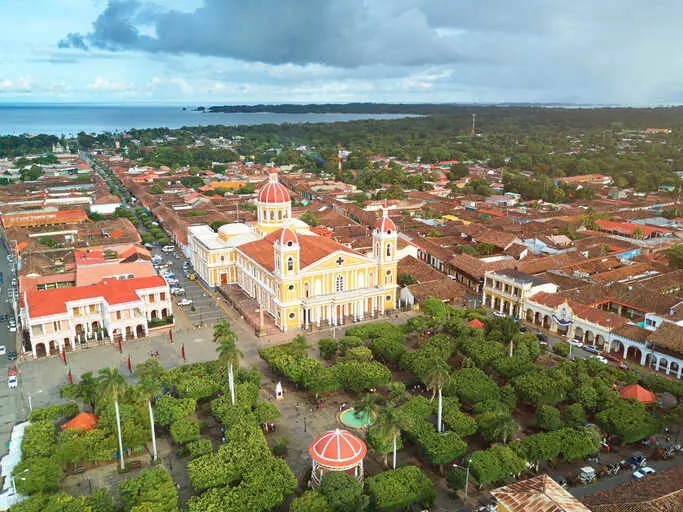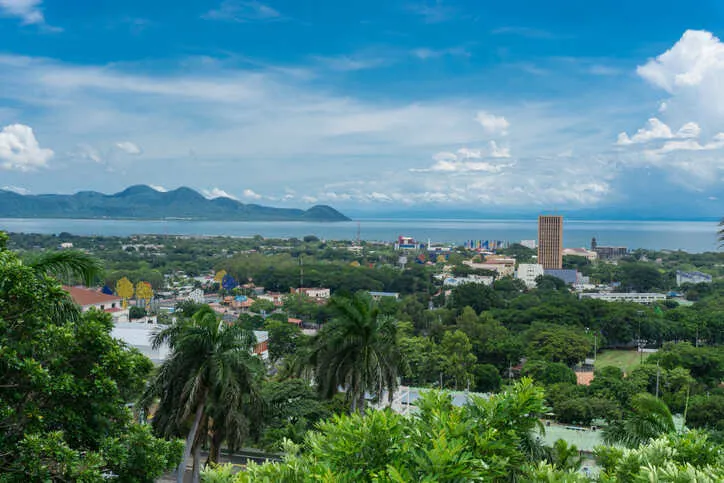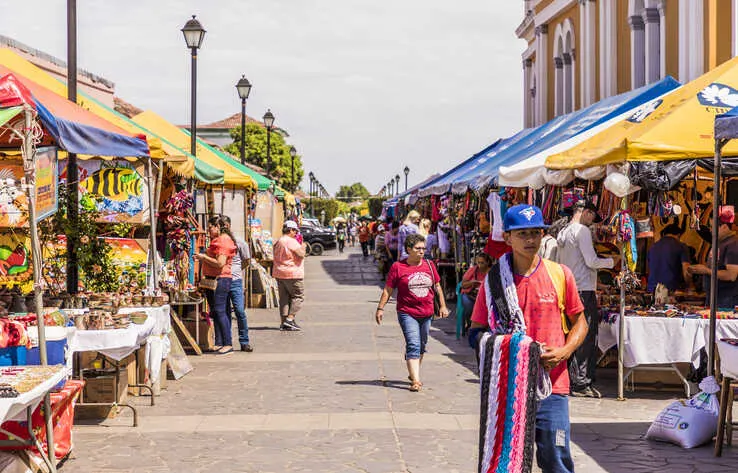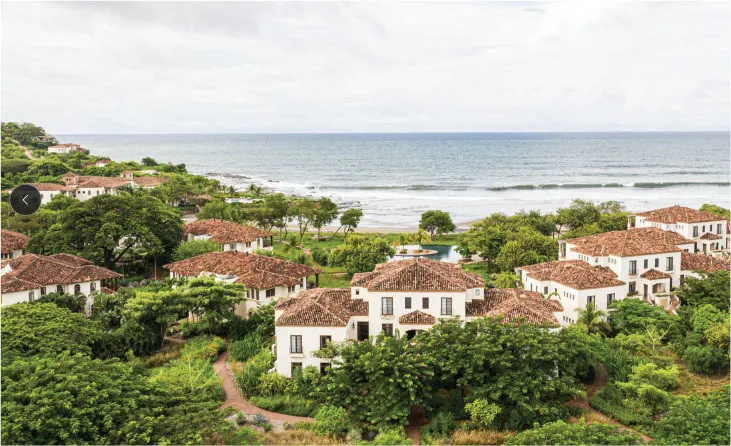Short of clenching a dagger between your teeth and creeping through the Honduran jungle with a band of cigar-chewing Sandinista rebels, the 7 a.m. Sansa flight from San José to Managua is probably the most dramatic way to enter Nicaragua.
When you have to be weighed before embarking—you and your luggage—it’s a tipoff that this isn’t going to be a generic short-haul 737 experience.
In fact, it’s a glorious exercise in orientation, as the single-engine Cessna threads the gaps between volcanoes, over mountain ridges, and within a stone’s throw of the expansive lakes that dominate southern Nicaragua. (OK, maybe more of a stone’s drop, but it’s close.)
Watching the terrain level out from the forested mountain ridges of Costa Rica north of Nicaragua to the fertile flatlands of the Managua plain is instructive—a reminder that despite their shared language and architectural similarities, the individual countries of Central America are each far more distinct in geography and character than you might expect.
How to Move Out of the U.S.
How to Move Out of the U.S.
In all sorts of beautiful, welcoming, culturally rich, saner places around the world, you can live well from $2,000 a month (all in, housing included). Sign up for our free daily IL Postcards e-letter and we’ll immediately send you a free report on the WORLD’S # 1 RETIREMENT HAVEN— plus 9 more spots you should have on your radar. Each day, you’ll earn about the best places to move to, retire, travel, buy real estate, and enjoy a good life for less, overseas.

By submitting your email address, you will receive a free subscription to IL Postcards, The Untourist Daily and special offers from International Living and our affiliates. You can unsubscribe at any time, and we encourage you to read more about our Privacy Policy.
A Bird’s Eye View of a Complicated Country

From above, the route I plan to take from Managua, through the jungle Baroque city of Granada, and down to the Emerald Coast at Popoyo, looks straightforward. From 15,000 feet above, traffic snarls and roadworks are curiosities rather than inconveniences. Banking hard to line up with the capital’s east-west runway, the disturbingly young pilot brings us down with featherbed softness.
I resist a perverse urge to lean over his shoulder and start flicking switches as we descend. No security bulkheads here.
The romantic broad-strokes overview from the Cessna’s cabin becomes a more complicated socio-political cross-hatch once I hit the ground. Nicaragua is an earthly paradise in many ways, but with a shadow of a surveillance-and-control state hanging over it. At airport immigration, I lie, and prudently declare my profession as "teacher."
Journalists are not welcome in Nicaragua, not since a series of demonstrations in 2018 escalated to a crisis that threatened the decades-long tenure of Daniel Ortega as president. Ortega’s response to the protests was brutal, seeing hundreds of protesters killed, human rights organizations evicted from the country, and media outlets muzzled.
Nevertheless, in the aftermath, many of the protesters’ original demands were met, even if Ortega’s waning popularity was hit hard. At this point, Nicaragua has settled back into a wary normalcy.
While my primary reason for being here is to explore, a side mission is to get a feel for daily life in the country, and whether the myriad treasures of this fascinating nation are compelling enough to offset the uncertainty of its future.
On balance, I’d say Nicaragua is worth serious consideration. A casual visitor to the country would notice nothing out of the ordinary, but it would be irresponsible of me not to mention the underlying tensions. If you come to visit, stay away from protests or demonstrations, avoid talking politics with locals, and don’t go taking photos or video of police or military personnel.
In the grand scheme of things, political dynasties come and go. More enduring is the character of a place’s people. By that metric, Nicaragua is among the world’s wealthiest nations.
Within five minutes of emerging from Managua airport, I’m taken in hand by a random mother and daughter combo who not only explain which bus I should take from the airport to the city center, but who proceed to pay my bus fare, accompany me onboard, and escort me to the depot where I catch the colectivo service to Granada.
Of all the small acts of kindness I’ve encountered while traveling for International Living (and there have been many— the world is a much, much kinder place than you might think), this is the most spontaneous and touching.
All I did was ask them if I was standing in the right place to catch the bus to the city, and they took it upon themselves to guide me through their hometown with genuine welcome, interest, and concern.
Managua: Vibrant, Tropical Countryside

Managua, on Nicaragua’s southwestern coast, peters out into tropical countryside quickly. Once you get past the procession of strip malls, hypermarkets, and garden centers that encrust most modern city suburbs, the roadside quickly reverts to mixed agricultural and residential zones, lined with glossy-leafed hardwoods and coconut palms framing an imperial blue tropical sky.
As is customary in Central America, colors seem more vibrant here; the harsh perpendicular sunlight somehow gets soaked up, softened, and re-broadcast by foliage and exuberant blooms.
A private car would make the journey from Managua to Granada in under an hour, but since my new-found Managua family put me on a colectivo bus and waved me off, the timescale is closer to 90 minutes. On the upside, the 30-mile journey costs me 36 cordobas—just under a dollar.
A Stopover in Clubby, Cool Granada
Arriving in Granada city is an experience that puts the senses on high alert. Not out of edginess or danger, more due to the vibrancy of it all. Decidedly warm and humid, the 85 F heat of daytime wraps the body in a duvet of steam-room cloy. It’s sticky, and in the morning at least, busy with the loud soundtrack of commerce and graft.
However, there is freshness to be had in Granada, as the daily katabatic winds that blow from the lakeside at the east of the city channel up the pedestrianized mainstreet of Calle la Calzada.
Strolling down the Calzada, on the lakeside malecón promenade, or just standing on the steps of the artfully crumbled Señora de Guadelupe church is a joy, as a stiff breeze whips your shirtsleeves and cools your skin with frangipani-scented lake air.
La Calzada is mostly a bars-and-restaurants strip. The courtyard at the back of Pan de Vida pizzeria is a gathering spot for Granada expats on Friday afternoons from about 4 p.m.
It’s a popular choice. The beers are cold, the cocktail list extensive, and you can pick up a blackened mahi-mahi sandwich with cream cheese and salad for $8.50. It’s contemporary international fare, and pricier than what you’ll find in the local joints off the Calzada, but in the balconied and beflowered courtyard of a colonial townhouse, it’s worth the price for the company alone.
Expat groups tend to reflect something of their adopted home. In Pan de Vida, there’s a clubby atmosphere reminiscent of the officers’ club in Rangoon, circa 1930, or a gaggle of war correspondents sharing leads and bottles of black market Scotch in a Beirut hotel bar sometime around 1982.
I asked them what might happen when, inevitably, Daniel Ortega dies. Every person of whom I asked this question had a different theory, ranging from "his wife will continue," through to "he’s already dead, they just haven’t announced it yet."
The range of answers isn’t important; the telling detail is that not one person wanted to go on the record with their opinion. The expat scene in Granada is old-fashionedly analog because anything you write on an online forum is a permanent record of your existence and views.
Expat living in Nicaragua is rewarding, affordable, convivial, and brimming with potential… but it comes with caveats. The most important of those is that you stifle any freedom-born impulse to be vocal about the Ortega regime.
Strolling around Granada’s Old Town and taking in the atmosphere is interesting enough to keep you busy for hours. It’s languid, warm, and once you get into the pace of it, you can easily spend a morning watching Nicaraguan retirees playing chess, or following the measured progress of a uniformed street sweeper pushing a dustcart along on three-inch gauge, solid hardwood wheels.
Thick hardwood is a recurring theme in Granada, as is fitting for a forested tropical nation. Build well, and build to last is the motto, and whether it’s the solid heft of a hotel room door or the age-worn patina of a grandmother’s rocking chair on the porch (I’m not making this up—many a stately Granada townhouse comes with a sharp-eyed abuela sat out front as the evening draws in), mahogany, teak, and various more obscure hardwoods accent just about every indoor space.
The Comforts of a Local Market

If woodworking is your thing, don’t miss the municipal market three blocks south of the cathedral.
Nicaragua is rewarding and convivial.
While the approach to the market building proper is a maze of stalls selling the usual mishmash of cheap clothing, cellphone covers, and knock-off sunglasses, the interior is a warren of narrow lanes winding between fresh produce stalls, slightly offputting butchery displays, and chaotic hardware arrangements.
Wander long enough and you’ll eventually find the carpentry section of the market, where single planks the size of snooker tables lean in drying stacks next to workshops, where carpenters use hand tools to build robust tables, chairs, and cabinets.
Granada’s local style of rocking chair is an aesthetically comforting series of chunky, relaxed curves. I defy anyone seeing them stacked for sale in the city’s market not to want one.
Wend your way a little farther into the market (follow your nose), and smiling matriarchs in floral aprons cook stews, soups, and rice dishes on open wood fires. Soup in Nicaragua is a full meal, served from steaming cauldrons the size of cut-off oildrums. A two-pint bowl costs around $3, and comes with a maize flatbread to soak it all up.
Tables are set up in a jaunty, exposed beam dining room with fine views of the surrounding city; décor is cheerful folk art and decommissioned farm implements.
It’s all bright and well-scrubbed, which is just as well because Nicaraguan soup demands that you get your fingers wet. Pulling out chicken bones or beef ribs to chew on is an expected part of the experience. Chunks of yucca, potato, cabbage slices and root vegetables bulk out the broth, whether you opt for the chicken or beef version.
Alternatively, sliced stewed beef served with rice, yucca chips, and red beans is another staple worth trying. It’s not haute cuisine, but it’s honest, local fare that’s as much part of the Nicaraguan experience as any cathedral or museum.
For more recognizable Western dishes—wings, ribs, burgers—Beer House Sports is Granada’s current hot spot. Eat al fresco at the tables in the arcaded courtyard of this 18th-century townhouse, grab a local Tona beer, and if you feel inspired, head upstairs to the dancefloor and stage. (Live music on weekends, mains from $9.)
Where to Stay in Granada
I stayed at Il Padrino, around the corner from the Convento de San Francisco—a small, basic hotel where a double room with breakfast included cost a little under $40 a night.
A little more upscale is the Hotel Casa San Francisco, a sympathetic colonial restoration owned and run by Californian sisters, Terry Leary and Nancy Bergman. For outright architectural opulence, the Hotel Dario on La Calzada is a Granada landmark, with courtyard garden, pool, and old-world ambience from $150 per night per double.
Popoyo: The Emerald Coast
South from Granada to the Pacific coast, the Pan-American Highway gets to within 15 miles of the ocean on its way through the country, but there are no sea glimpses to be had.
Instead, it’s carefully-tended maize and grassland that flanks the roadside. Finger-sized lizards move in their jerky, stop-motion fashion up the white-painted trunks of ceiba trees while, on the quieter stretches of rough road between Ochomogo and the coast at Popoyo, capuchin monkeys squabble among the lime-green canopy of branches overhead.
More striking are the teams of white oxen pulling cartloads of timber. Muscular, statuesque beasts with lyre-curved horns, these are closer relatives of Andalucia’s famed fighting murcielago bulls than any domestic steer.
Coming across a pair of them hauling a flatbed trailer, their oversize hoofs ringing on the cobbles of a two-lane road cut through red clay and acid-green jungle, is a visual tableau that will burn itself on your mind’s eye and remain as long as you live.
I’m headed for Popoyo, a cluster of homes and businesses on a length of pale-sand Pacific known here as the Emerald Coast. It’s a stretch of open ocean corrugated by consistent warm-water waves.
To cater to the traveling surfers who seek them, the sweeping forested hills flanking the shore are peppered with surf lodges, hostels, yoga retreats, and hammocky cafés serving fruit smoothies in Kilner jars.
Popoyo is less a fixed destination than it is a state of mind. Palapa surf lodges on the water’s edge, pale sand beaches hemmed by jutting rocky headlands, teams of fishermen hauling brightly painted wooden boats onto shore, uncrowded beach-break waves, egrets dipping for shrimp in palm-lined lagoons… Popoyo has it all. What it does not have is an ATM, so bring cash.
Low-rise surf lodges are the main accommodation option, mostly in the $70-$80 per night range. Las Plumerias is a well-regarded, low-impact option with pool, surf rental, yoga, and various outdoor activities.
Dutchy’s Deli at the east end of Calle Guasacaste serves a solid breakfast along with probably Popoyo’s best burger, and has the advantage of being next to Ocean Market—the nearest thing the village has to a superstore.
Getting to Popoyo on public transport is possible, but it’s a headache. Apart from a few intrepid surfers, there aren’t enough people moving around this forgotten section of Pacific to make a frequent service worthwhile.
Your best bet is to take a bus to the lakeside town of Rivas (embarkation point for Ometepe island, if pristine double-volcano biosphere reserves and crater lakes are on your must-see list) and wait for a Popoyo-bound colectivo to fill up with passengers. Or simply pay $40-$50 to charter it for yourself.
Journey time is around 90 minutes. Alternatively, a bus from Rivas station to Guasacate gets you within five miles of the coast, and you can take a taxi from there to your accommodation.
Amenities and urban energy are not Popoyo’s strong point. Instead, imagine yourself in 1940s Malibu, before stripmalls and webcams and inflated California property prices, with hiking trails into the mountains, the smell of salt spray on the air, and a decade or two to enjoy it all before word gets out and the hordes descend.
Rancho Santana: "More Than Luxury, It’s Quality"

Just across a shallow creek at the south end of Popoyo beach starts the landscaped and groomed garden area of The Inn at Rancho Santana. It’s the main beach club, pool and gathering area for the extensive gated community, and a focal point for residents. It also offers rooms (from $380 for doubles), fine dining, and a walk-in cigar humidor (because who doesn’t need a walk-in cigar humidor?).
The mission-style building of The Inn and Clubhouse is an airy stone-and-timber affair that evokes grand plantation living—think ceiling fans and sturdy wicker banquettes—accented with local details. Tiled areas recall the colonial townhouses of old Granada; glazed clay vases, decorative ceramics, and painstakingly worked parquet ceilings acknowledge the arts and crafts traditions of southern Nicaragua.
You’ll find that same attention to detail in all the accommodation options at Rancho Santana, which include two-bedroom casitas from $450 a night right up to seven-bedroom villas or fractional-ownership condo programs. It’s high luxury indeed; accommodation and dining at Rancho Santana is a perfectly balanced combination of largesse and taste, but it’s more than that.
Rancho Santana recalls the traditional arts and crafts of Nicaragua.
In fact, luxury is not the right word here. Any fool can do luxury—all that takes is money. A more appropriate term is quality. Your bedside drawers are dovetailed hardwood and glide to a stop with a satisfying thud. The shutters on the bathroom windows are hand-finished louvers.
Sink into the deep cushions of the couch on your private, ocean-view terrace and you’ll find yourself supported by the same chunky heft of teak framing as those Granada rocking chairs.
It turns out that Rancho Santana makes its own furniture onsite. And grows its own produce. And trains its own chefs. And fields its own baseball team. And, alongside the yoga retreat and surf school and mountain biking and al fresco dining options, features a fully functioning high school, supermarket, and housing units for its staff of over 1,000 workers.
From the visitor’s point of view, what you’re paying for here is restraint. Every home on the property has a sea view, which is only possible because so few lots are sold. Where another developer might have packed condo units in, the distribution here is so sparse that you have to look hard to see the houses.
That’s a different, rarer development philosophy than the pile-‘em-high approach at, say, Cancún or Jacó, and the result is a level of exclusive privilege that simply doesn’t exist elsewhere.
I take a tour of the beaches along the property’s two-mile stretch of ocean. The coast turns a corner eastwards, and includes a couple of craggy headlands that drop in sheer cliffs down to sandy bays. Playa Rosada turns pink in the light of the setting sun, the wider beach at Playa Santana channels rolling Pacific waves onto its fine sands, while Playa Escondida and Playa Los Perros are hidden tracts of soft beach nestled between golden sandstone outcrops and glittering deep-blue ocean.
The forest cover as you drive along the coast road is so dense that you’re almost at the water’s edge before you even realize there’s a beach there.
Hidden in the woodland above Playa Rosada, La Boquita restaurant serves up pizza, paella, and sushi at outdoor tables perched on a cutting overlooking the sea (look left and you can see Costa Rica). There’s also cocktails, loungers, and a plunge pool if you plan to make an afternoon of it. Mains run from $14.
From the non-denominational chapel on the ranch’s highest point, you can view most of the property. The chapel itself is a jewel, stone-built in California mission style with intricate stained-glass windows laboriously imported from a condemned Baltimore church. It’s a spectacular setting, popular for wedding ceremonies and photos, dramatic without being overwhelming. Southward, the last beach is Playa Colorado bay.
That’s where I spend a morning and much of an afternoon surfing the imposing reefbreak of Panga Drops in Playa Colorado. A solid A-frame peak with 200-yard rides, it breaks with all the muscle you’d expect from the open Pacific, and after a few hours I was more than ready for lunch at the beachside trestle tables of La Taqueria.
The special that day was rind-on pork tacos which, after a morning spent being flung around by a relentless ocean, could not have been more perfect. Apparently it came with fresh avocado salad and I also had a jug of jamaíca (a cooling hibiscus drink), but all I remember was that it went down fast. Surfing makes you very hungry.
I could have gone mountain biking, hiking, sandboarding, had myself pummelled in the onsite wellness retreat, or any combination of interesting pursuits. Frankly, after the surfing, I wasn’t able to go for any more physical exertion. A walk along the sand to pick up palm-sized sand dollars was all I could manage before flopping onto one of La Taqueria’s beachside deckchairs.
An exclusivity that doesn’t exist anywhere else.
Leaning back to look for monkeys in the overhanging ceiba trees, I couldn’t help notice an off-kilter lean to the roofline of the restaurant.
"Oh yeah," the instructor from the adjacent surf school explained, "they built it that way so that it wouldn’t get in the way of the tree."
Admirable stuff which, in a nutshell, captures the high-quality, low-impact ethos of the Rancho Santana project.
The metaphor extends the following day, as I head southward to cross the border to Costa Rica at Penas Blancas.
The frontier building is charmless concrete airport-chic, all smoked glass and urban efficiency, but the parking lot out front teems with last-minute fruit stalls, kids selling bottles of Tona from cooler buckets, and tin-roofed shacks lined with rows of hand-tooled leather sandals. A bull-cart trundles down a side lane. The symbolism is easy to read: build all you like, but traditional Nicaragua will remain. Long may it continue.
How to Move Out of the U.S.
How to Move Out of the U.S.
In all sorts of beautiful, welcoming, culturally rich, saner places around the world, you can live well from $2,000 a month (all in, housing included). Sign up for our free daily IL Postcards e-letter and we’ll immediately send you a free report on the WORLD’S # 1 RETIREMENT HAVEN— plus 9 more spots you should have on your radar. Each day, you’ll earn about the best places to move to, retire, travel, buy real estate, and enjoy a good life for less, overseas.

By submitting your email address, you will receive a free subscription to IL Postcards, The Untourist Daily and special offers from International Living and our affiliates. You can unsubscribe at any time, and we encourage you to read more about our Privacy Policy.
